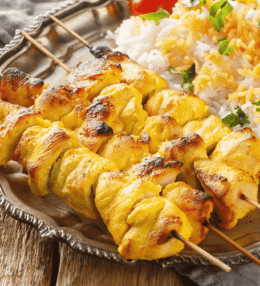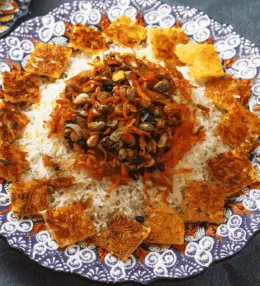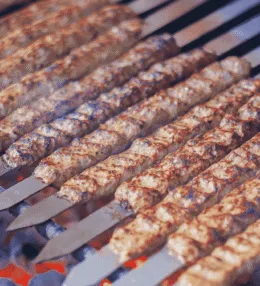
- View
Table of Contents
ToggleSerabi is one of those quiet cornerstones of Indonesian food culture. It’s a pancake, yes, but not the kind you might expect. Slightly crisp at the edges with a soft, spongy centre, Serabi brings together simplicity, aroma, and sweetness in a single warm round.
Often cooked over charcoal and eaten fresh off the griddle, Serabi is the kind of snack that turns up at morning markets and late afternoon stalls. It’s not flashy, but its texture and flavour make it something special.
Whether topped with coconut syrup or left plain, Serabi offers comfort without being heavy. It’s a dish that reflects the gentle pace of traditional Indonesian kitchens and the creativity of everyday home cooks.
Want to dive deeper into Indonesian Cuisine? Don’t miss our post on 31 Traditional Indonesian Foods to Try
What Is Serabi?
Serabi is a traditional Indonesian pancake, usually made from rice flour and coconut milk, then cooked in a small clay pan until lightly crisped around the edges. The centre remains soft, almost custard like in texture.
There are two main types: Serabi Manis, which is sweet and typically served with thick coconut sugar syrup, and Serabi Asin, a savoury version that may include toppings such as shredded coconut or fermented oncom.
It is served as a snack or breakfast item and is especially popular in West and Central Java. Though it’s made from simple ingredients, each version reflects regional traditions and the character of local tastes.
Ingredients and Taste
The batter is made by mixing rice flour with coconut milk and a pinch of salt. Sometimes yeast or baking soda is added to create bubbles and give it a light, airy rise when cooked. The mix is then ladled into small clay pans.
As the batter cooks, the outer rim crisps while the centre remains tender. The finished Serabi is soft and slightly chewy, with a subtle sweetness from the coconut milk and a hint of toast from the pan.
Sweet Serabi is often finished with a pour of coconut sugar syrup, thick and dark, which seeps into the sponge and adds depth. The savoury version brings in toppings like spring onion, coconut flakes, or spicy fermented soybean.
A Taste of History
Serabi has long roots in Javanese culinary tradition. It’s believed to have originated centuries ago, made in village kitchens using rice from nearby paddies and coconut milk pressed by hand. It was simple food, meant to nourish and satisfy.
Cooking over clay stoves was once the norm, giving Serabi its smoky edge. Even today, some street vendors stick to this method, valuing the flavour it brings. In many towns, Serabi is still linked to daily rituals and local gatherings.
Over time, variations emerged. In Bandung, Serabi is often modernised with colourful toppings and creative flavours. In Solo and Yogyakarta, the more traditional version holds firm, relying on coconut milk and palm sugar for richness.
Despite changes, the essence remains: Serabi is food that honours the past while staying part of the present. It’s not loud or attention seeking. Instead, it invites you to slow down, take a bite, and taste something both familiar and quietly beautiful.
How to make Serabi
Serabi is a traditional Indonesian pancake made from rice flour and coconut milk, often cooked over charcoal for a smoky touch and served with a rich coconut sugar syrup. Expect slightly crisp edges with soft, airy centres. The batter is simple but timing and heat control are key to perfect texture and taste. See the recipe card at the bottom for printable directions
Ingredients
For the pancakes
- 200g rice flour
- 2 tbsp plain flour
- 1 tsp instant yeast
- 1 tbsp sugar
- ¼ tsp salt
- 300ml thick coconut milk (warm, not hot)
- 100ml water (adjust as needed)
- 1 pandan leaf (optional, knotted)
For the syrup (kinca)
- 150g coconut sugar (or palm sugar), chopped
- 150ml thin coconut milk
- 1 pandan leaf (optional)
- A pinch of salt
Cooking Instructions
Step 1: Activate the yeast
To begin, combine warm coconut milk, sugar, and yeast in a small bowl. Let it sit for 10 minutes until frothy. This step helps ensure your batter rises properly. Move on to mixing the dry ingredients.
Step 2: Mix the flours
In a large bowl, sift together the rice flour, plain flour, and salt. Mixing the two flours gives the pancake both structure and softness. Prepare to combine with the wet mixture.
Step 3: Make the batter
Pour the yeast mixture into the flour bowl and stir gently to combine. Add water slowly until a thick yet pourable batter forms. Cover and rest in a warm place for 1 hour or until bubbly. Continue with syrup preparation while batter rests.
Step 4: Make the syrup (kinca)
In a small saucepan, add coconut sugar, thin coconut milk, pandan leaf, and a pinch of salt. Simmer over low heat until the sugar dissolves and the mixture slightly thickens. Strain and set aside. Proceed to heat the pan for cooking pancakes.
Step 5: Preheat the pan
Heat a small clay pan or heavy bottomed non-stick pan over medium heat. If using a clay pan, preheat slowly to avoid cracking. Move to the next step once the pan is hot.
Step 6: Cook the pancakes
Ladle a small amount of batter into the centre of the pan without spreading. Cover with a lid and cook until bubbles form and the top is set, around 3–5 minutes. There is no need to flip. Transition to removing and repeating.
Step 7: Remove and repeat
Once the surface is no longer wet and the edges are lightly crisped, remove the pancake and place on a plate. Repeat with the remaining batter. Keep cooked pancakes loosely covered to retain softness.
Step 8: Warm the syrup
Before serving, gently reheat the syrup if it has cooled and thickened too much. Warm syrup soaks in better and enhances flavour. Prepare the dish for final serving.
Final step: Serve with syrup
To serve, pour warm kinca syrup over each pancake or serve it in a small bowl for dipping. For added authenticity, plate on banana leaf or garnish with grated coconut.
Variations and substitutions
- Add mashed ripe banana or jackfruit to the batter for flavour twists.
- Replace pandan with vanilla if unavailable.
- Use dairy milk mixed with coconut essence if coconut milk is not accessible.
Cooking Tips for Perfect Serabi
- Use thick coconut milk in the batter to create the signature richness and slight crispness.
- Let the batter ferment fully to develop flavour and bubbles.
- Cook covered to ensure the top sets without flipping.
- A clay pan enhances authenticity, but a thick pan works well too.
- Use medium heat to avoid burnt bottoms and undercooked tops.

Serabi (Indonesian Pancakes)
Ingredients
For the pancakes
- 200 g rice flour
- 2 tbsp plain flour
- 1 tsp instant yeast
- 1 tbsp sugar
- ¼ tsp salt
- 300 ml thick coconut milk warm, not hot
- 100 ml water adjust as needed
- 1 pandan leaf optional, knotted
For the syrup (kinca)
- 150 g coconut sugar or palm sugar, chopped
- 150 ml thin coconut milk
- 1 pandan leaf optional
- A pinch of salt
Instructions
- To begin, combine warm coconut milk, sugar, and yeast in a small bowl. Let it sit for 10 minutes until frothy. This step helps ensure your batter rises properly. Move on to mixing the dry ingredients.
- In a large bowl, sift together the rice flour, plain flour, and salt. Mixing the two flours gives the pancake both structure and softness. Prepare to combine with the wet mixture.
- Pour the yeast mixture into the flour bowl and stir gently to combine. Add water slowly until a thick yet pourable batter forms. Cover and rest in a warm place for 1 hour or until bubbly. Continue with syrup preparation while batter rests.
- In a small saucepan, add coconut sugar, thin coconut milk, pandan leaf, and a pinch of salt. Simmer over low heat until the sugar dissolves and the mixture slightly thickens. Strain and set aside. Proceed to heat the pan for cooking pancakes.
- Heat a small clay pan or heavy bottomed non-stick pan over medium heat. If using a clay pan, preheat slowly to avoid cracking. Move to the next step once the pan is hot.
- Ladle a small amount of batter into the centre of the pan without spreading. Cover with a lid and cook until bubbles form and the top is set, around 3–5 minutes. There is no need to flip. Transition to removing and repeating.
- Once the surface is no longer wet and the edges are lightly crisped, remove the pancake and place on a plate. Repeat with the remaining batter. Keep cooked pancakes loosely covered to retain softness.
- Before serving, gently reheat the syrup if it has cooled and thickened too much. Warm syrup soaks in better and enhances flavour. Prepare the dish for final serving.
- To serve, pour warm kinca syrup over each pancake or serve it in a small bowl for dipping. For added authenticity, plate on banana leaf or garnish with grated coconut.
Nutrition
You May Also Like







Leave a Review